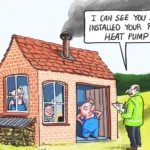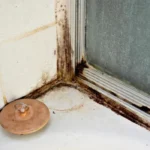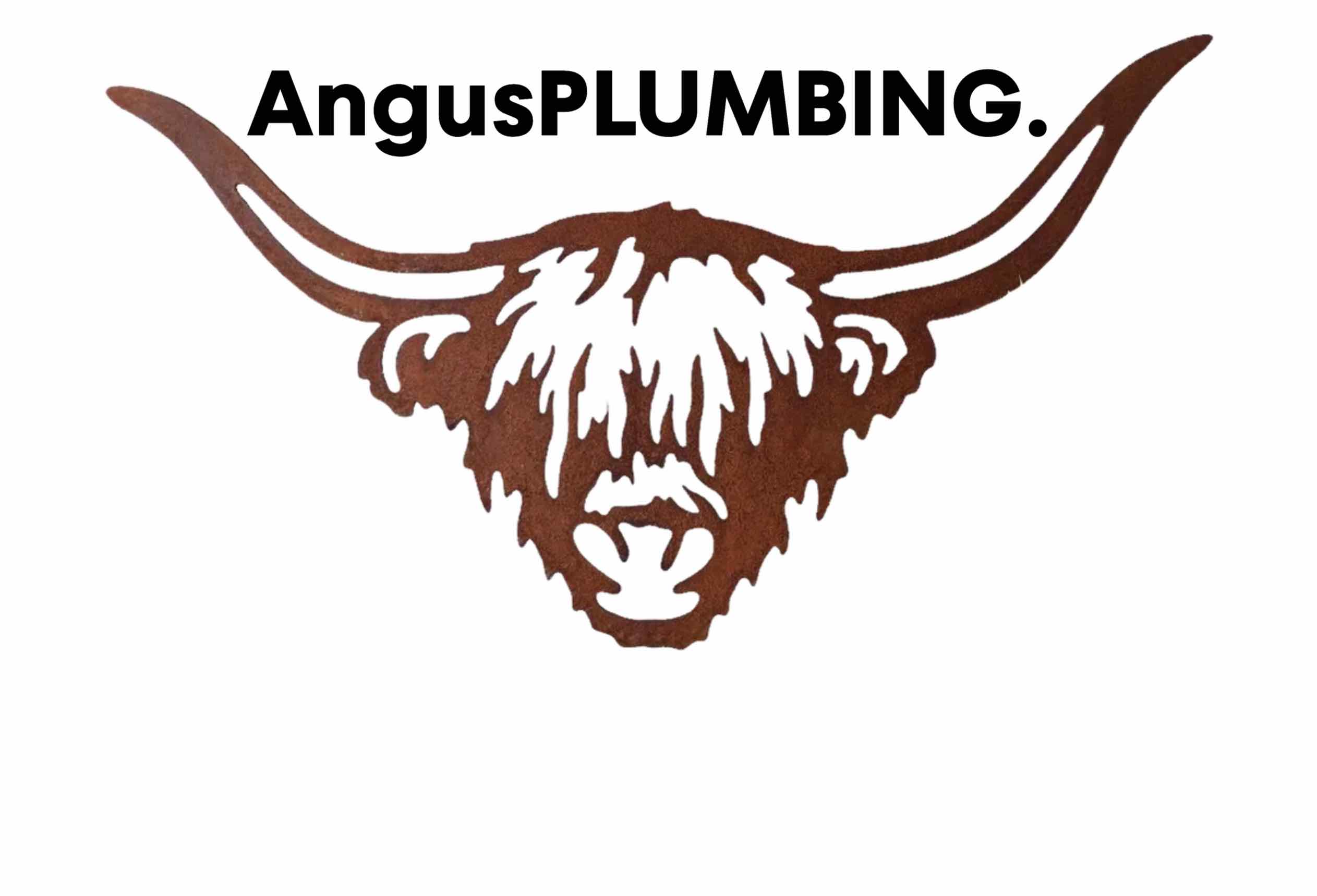
The complete guide to UK heat pumps - 2023.
Heat pumps – types, how they work & the best for your home
The law. Gas boiler ban? Mandatory heat pumps??
Cost – buying, installing & running
Hidden costs and deal breakers
Free money – grants, subsidies & tax incentives. Jam today? Cake tomorrow!!
Insurance – specialist coverage required?
Efficiencies – energy, carbon etc.
Savings – how much to really expect? Are heat pumps really worth it?
Can heat pumps be shared? And what about district networks and shared ground loops?
And much, much more….

Plumber - Paul
Paul's a member of the Chartered Institute of Plumbing & Heating Engineers, Water Regs UK (formerley WRAS – Water Regulations Advsiory Scheme) certificated as well as a qualified unvented cylinder engineer and a qualified heat pump engineer.
Hello! And welcome to another AngusPLUMBING blog.
And you’ve guessed it, this one’s about much in the news heat pumps – the low carbon, gas boiler alternative.
We know the blog’s on the long side, but there’s a lot to cover. Helping, we’ve split it into parts, upped the navigation and included as many charts, diagrams and examples as we could.
Make no bones about it, switching to a heat pump’s an expensive decision. And one where you really should know what you’re getting into and what to lookout for before you make the investment.
As ever, we hope that you find our thoughts helpful. Of course get in touch if you’d like to talk anything through or have any questions about heat pumps or other fossil fuel alternatives.
Best as always
Angus, Paul and the AngusPlumbing team.
Let's get going....
Perhaps,you just want to know more about heat pumps?
Or, you’re already on the way to ditching your current gas boiler and going down the heat pump route? You’ll save money and cut your carbon footprint? Right? Well, that’s what the media and government say?
A trawl of the web left us scratching our heads.
Can you, should you believe the politicians?
What about the broad sheet media? Well, we all know with its falling subscriptions it’s got its own click-bait agenda, swinging one way this week and another the next.
And if heat pump manufacturers, and heating industry bodies aren’t flying the heat pump flag – well that would be odd indeed.
“Heat pumps are the frontrunner to replace gas boilers over the coming decades as the country moves towards net zero.” The Telegraph
“Nobody’s buying heat pumps because they’re an awful product.” The Telegraph
“Six reasons to buy a heat pump.” The Guardian
“How Britain’s heat pump revolution turned out to be a lot of hot air – Lords warn rollout is ‘seriously failing’ amid criticism of ‘pathetically low’ uptake.” The Guardian
“British Gas admits heat pumps can leave your home colder than a gas boiler.” BBC News
“In just 12 years’ you probably won’t be able to buy a gas boiler anymore.” Justin Rowlatt. Climate Editor, BBC News

Flummoxed?
We certainly were, so for an afternoon we put down our trusty spanners. And took a long hard look at heat pumps with the aim of helping you make the decision of whether the heat pump route is a potentially viable one. And if it is, whether now’s the best or even a good time to consider ditching your gas boiler

Elephant in the room?
Let’s deal with Nellie first – the adverts and stories causing us the most concern. And potentially forcing the issue. Is there going to be a ban on gas boilers? And if there is, will homes have to replace them with a greener alternative?
No matter what you’ve read or heard, the truth of it is that there’s no gas boilers legislation coming in either before or after 2025 forcing you to replace or scrap your existing gas boiler.

So, if your gas boiler’s still doing a good job (with an A or B energy efficiency rating) and‘s relatively new, you may not want to get rid of it.
But, if yours is getting on a bit and towards the foot of the energy efficiency ratings, an upgrade and possibly to a heat pump might make sense. We’ll explain though why waiting, if you can’ll be a good idea.
Bans and the law etc.
2025? So, what if anything boiler or heating related is “banned” or “outlawed” from 2025?
Homes built in 2025 and forward must use an energy efficient non-gas heating system. This also applies to those where there’s a major renovation – a house built before this with only a small amount of the original remaining.
With gas not an option, these “new-builds” will have to use an another heating method. And this is where heat pumps enter the equation, but there’s other alternatives – hydrogen boilers, bio-mass boiler etc. that would equally do.
Now, it’s unlikely that substantially more than 150-200k new homes will be built annually (yes, we could do with them especially with 800,000 plus people joining the electoral role each year – but one for another day).
With this small market, it’s no wonder that the energy companies and heat pump manufacturers are going hard with their internet advertising and why some of this may be stretching the truth.

Aha….
Okay, if you’re the owner of one of the 29 million homes built before 2025 and need to or are thinking about replacing your gas boiler, wipe your brow as the ban won’t apply to you.
Yet….
Until possibly 2035, where as it stands, and things do change, and sometimes very quickly, you won’t be able to replace your gas boiler with a like for like, new fossil fuel boiler.
Unless of course you fall into the government’s recently updated list of exceptions. With 12 years to go, you can expect these to change. But we need to plan for what we do know. Currently, these exceptions are only in outline and therefore vague and include homes where owners will “struggle financially” or “where a new large electricity connection’s needed” – i.e off-grid-gas-homes.
Oh and yes, and “where retrofitting would be prohibitively expensive”.
So far, these are all of the “special” government exceptions we’ve heard of. And more are likely especially with the current political situation.
The result, with a finger in the air, it looks like a sizeable chunk, some 20% of UK homes could potentially be exempt.
With 2035 some way off – we’ll have to wait and see though. And we’ll keep an eye on this and let you know how this develops.
What we do know with certainty, is that there are no plans to phase out gas boilers here in the UK any time soon.
So, what about heat pumps? As far as the role of these in meeting this target is concerned? Well, the government’s announced ambition of installing 600,000 heat pumps annually by 2028 – as part of this, looks very hmm to say the least.
Why? Well last year – 2022, UK heat pump installations reached an all-time high of 55,000 units.

And as of August 2023, things weren’t looking particularly rosy. Since the start of the year, just 18,000 new heat pumps had been fitted in the UK from some 23,000 applications.
The government’s legislative stick and subsidy carrot – coaxing homeowners to ditch gas in favour of cleaner alternatives clearly isn’t cutting the mustard. Perhaps, they should take a peek at the French where 2022 saw more than 620,000 new heat pumps plumed in and running.
BTW – Since 2008, France has been busy building a professionalised heat pump sector.
By 2019, this was supporting some 32,000 jobs and was worth c€5.3 billion or £4.6bn. The UK in the same year, looked no more than a quaintsy cottage industry – with just some 2,000 full-time people employed in the four nations’ heat pump industry. Oh.
Heat pump. So, if I don’t have to have one, are they worth considering?
As with any other investment, there’s a number of things that you’ll want to take a deep dive into.
For most people, the purchase price and running costs are going to be front and centre, but environmental benefit – cutting carbon footprint is also up there. We’ll go into these shortly.

The question that “they” don’t want you to ask….
And then there’s the bogey question that most of the heat pump industry brushes under the mat. Is your home suitable? And by this we mean suitably insulated. If it’s not, you simply won’t get the claimed cost savings and will more than likely end up spending more on heating than ever.
Now there’s good reason why Britain’s known as the “Cold Man of Europe”. Look no further than our aged, poor-quality housing stock.
For a heat pump to run efficiently, the spend on the new insulation you’ll need may well be wincing and could send you running to the hills. Because for many homes, you can add in the cost of triple or even quad glazing windows and doors, wall cavity stuffing, loft lagging, floor insulating and pipe wrapping etc. And if you’ve got micro-bore central heating pipes – 6, 8, 10 or 12mm to get to an acceptable hot water flow – replacing all these pipes or at least adding some pumps etc. will definitely be on the cards.
And there’s more. You’ll also need to include new/larger surface area radiators – after all heat pumps produce less heat that a gas boiler. Or if you ditch the rads and go the underfloor heating rout you’ll need to factor this cost in as well, and also the disruption and inconvenience you’ll get having your floors lifted.
Oh, and if you’ve a gas cooker, you’ll need to think whether paying the gas standing charge for this alone is worth it or forking out on an electric cooker is a better call.
You’ve lots to ponder.
Bet you didn’t see this coming - your home insurance doesn’t cover heat pumps!
This was news to us when we first heard the rumblings. But we did some research, and it looks like many home insurance deals don’t cover heat pumps. Sighing, we went and dug out our policies out for a little look.
And yes, ours pays out for urgent repairs to things like boilers and covers gas central heating. But not “electrical” heat pumps. The one thing that it had in spades was vague wording and reams of exclusions – things that the policy doesn’t or won’t cover.
The result – if we’d swapped our trusty gas boiler for a heat pump, our insurance wouldn’t cover emergency electrical repairs – leaving us facing bills of thousands of pounds plus.
For many home owners, it may be similar and if something mechanical happens with your heat pump and your insurer gets funny with you don’t be afraid to go to the Financial Ombudsman Service (FOS). It’ll be a pfaff but it’s better than chucking thousands of pounds away and you’ll generally find the FOS sympathetic and helpful.
Free money? Yes. But more’s on the way. Heat pump grants (Boiler Upgrade Scheme).
All of this said, there’s been much made of the UK government’s Boiler Upgrade Scheme. This kicked off on 1 April 2022 (April the first – all fools day really? Yes!) and is due to run until 2025.
The scheme replaced and updated The Clean Heat Grant and works on the same premise.
To be eligible, your home must have a current (issued in the last 10 years) energy performance certificate (EPC) with no outstanding loft or cavity wall insulation recommendations.
And from its outset contributions of £5,000 and £6,000 were available, of course subject to conditions’ if you bought and had installed an air source or ground source heat pump.
October 2023 saw these grants increase to a uniform £7,500 as the UK continued to slip behind its government set carbon targets.
30,000 grants annually were initially planned for in England and Wales, but only half that were managed in the in the first year. If take up continues to splutter, much of the £450 million grant funding available to 2025 will simply return to the Treasury’s coffers.
And you can bet your hat, these contributions will only increase, and probably sooner rather than later as under a 2018 law, the UK government must reach net zero.
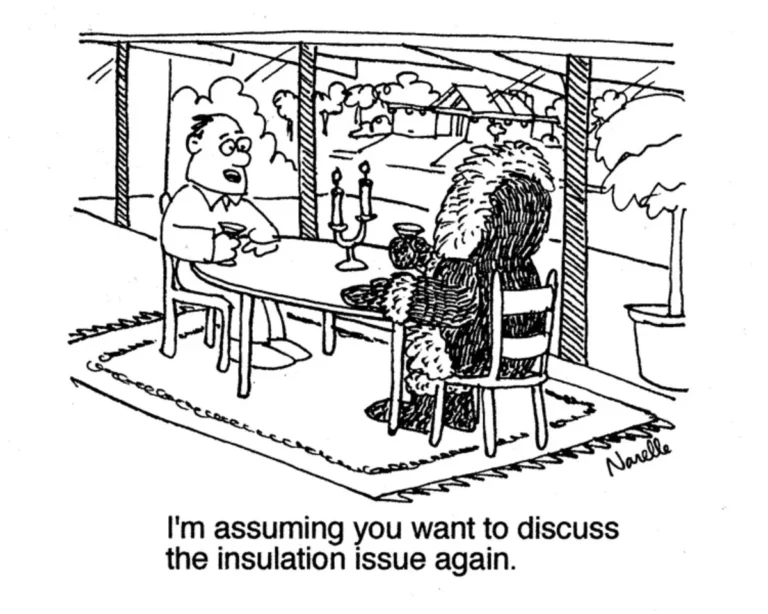
The Great British Insulation Scheme – pah for most of us.
Previously known as ECO+ the Great British Insulation Scheme was relaunched this summer and’s running to 2026. The government’s set out to deliver some 376,000 insulation measures – from loft to solid wall insulation.
Oooh interesting. Why? Because it gives medium and larger energy companies the obligation to help selected households cut their energy use through insulation.
Currently though, its limited to the lowest income and most vulnerable households and the least energy efficient homes (Energy Performance Certificate rating of D-G, and within Council Tax bands A-D in England and A-E in Scotland and Wales).
So, don’t hold your breath as this works out as only to some 300,000 households – a mere 1% of UK’s homes, where its aiming to save them around £300 to £400 a year on their bills. For most of us then – it’s not particularly GREAT.
Heat pump VAT - about turn.
VAT on heat pumps has also been scrapped until 2027 when in March it’ll return to 5%. Our bet is that when the 2027 budget comes around VAT will be back to zero as the politicians rake the cupboards for all of the Carbon Net Zero incentives they can muster.

How much?
These financial “incentives” are helpful, but for many home-owners heat pump technology will remain out of reach. Explaining – you’ll be looking at anywhere between £5,000 and £45,000 for an installed heat pump.
Of course, this’ll vary for different homes and types of heat pumps.

For a ground source heat pump – you’ll typically pay £13,000 to £35,000 but prices can reach £45,000+ pending on drilling and pinning needed etc. We’ll look at this later on.
For an air to water or air to air heat pump it’ll be £5,000ish and we’ve seen £3,000 quoted at the very bottom and up to £18,000. But as always you pay for what you get, and a cheap and cheerful air source pump won’t get near heating a three let alone a four or more bed house.
And for a water source heat pump – £10,000 will see you right.
So, you’ll still need deep pockets or to take out a loan and hold yourself hostage to interest rates that are still pretty steep.
Running costs - heat pump efficiency?
Compared to traditional heating methods, electric heaters and gas boilers etc – heat pumps with their heat transfer instead of generation, are unarguably more efficient. And it’s this efficiency that can potentially provide energy bill savings.
For those interested – heat pump efficiency is measured by CoP – the coefficient of performance. And if you do go down the HP route, you’ll probably become an expert in this. Oh, and yes – a higher CoP indicates a more efficient heat pump.
Good to know.
This CoP ratio depends on the temperature of the outdoor ground, water or air that’s being used. And for those that like a formula –
Heat pump CoP = Heating output/Energy Input
In most circumstances, ground-source heat pump running costs with a typical CoP ranging from 3.5 to 4.5 produce the greatest savings. Air source heat pumps are on their tail with an expected CoP ranging from 2.5 to 2.8. Water source heat pumps come in the middle with an expected CoP of 3.0 to 4.3. And gas boilers. Well, 0.9 at best.
Seasonal Performance Factor (SPF).
So, by now you’ll know that the CoP is the efficiency when operating at certain temperatures. And when you’re doing your calculations, you’ll need to bear in mind that this will vary over the seasons.

Annual savings?
So how much can you save? This’ll depend on the size of your home, how well its insulated and of course the temperature you want your home to be.
To get a better idea of how much a heat pump would cost to run, and whether it may be cheaper than your heating system, plug in your data to our example for a typical household currently using a gas boiler.
Typical household gas consumption is 12,000kWh a year.
Gas used for cooking makes up around 2.5% of the total (300kWh), so that leaves 11,700kWh a year as the typical quantity of gas used for heating and hot water in your home.
From July 2023, the average price cap for gas is £0.08 per kWh, so the annual cost of gas consumption is 11,700 x £0.08 = £936.
From July 2023, the average gas standing charge is £0.29 per day, so the annual standing charge cost is 365 (days) x £0.29 = £105.85.
The total gas bill for heating and hot water (excluding cooking) is £1,041.85.
What’s your heat demand?
To calculate the cost of running a heat pump, work out your household heat demand using your boiler efficiency and current annual gas usage.
A new A-rated gas boiler must be a minimum of 92% efficient; but the actual in-use performance is generally lower. As older boilers are also less efficient, we’ve used an average of 85% efficiency.
Current gas consumption is 11,700kWh. However, as only 85% of this is being turned into heat, the actual heat demand at 11,700 x 0.85 = 9,945kWh.
Potential heating and hot water costs using a heat pump
A typical air source heat pump will generate shy of three units of heat for each unit of electricity it uses. We’ve assumed a CoP (Coefficient of Performance) of 3.0 (300% efficient) – a nice round number for easier calculation.
To deliver the heat demand of 9,945kWh, the amount of electricity required will be 9,945 ÷ 3 = 3,315kWh.
From July 2023, the price cap for electricity is £0.30 per kWh, so the annual cost of electricity for heating and hot water is 3,315 x £0.30 = £994.50.
We’ve also assumed that all households already pay the standing charge for electricity, so there’s no need to add this.
Well, is a gas boiler or an air source heat pump cheaper to run?
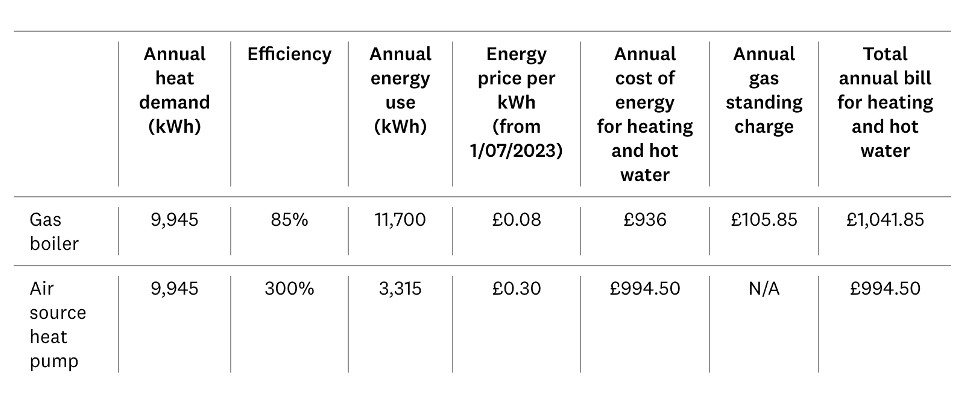
A typical air source heat pump will generate shy of three units of heat for each unit of electricity it uses. We’ve assumed a CoP (Coefficient of Performance) of 3.0 (300% efficient) – a nice round number for easier calculation.
To deliver the heat demand of 9,945kWh, the amount of electricity required will be 9,945 ÷ 3 = 3,315kWh.
From July 2023, the price cap for electricity is £0.30 per kWh, so the annual cost of electricity for heating and hot water is 3,315 x £0.30 = £994.50.
We’ve also assumed that all households already pay the standing charge for electricity, so there’s no need to add this.
In this example, the annual costs are similar. Gas boiler £1,041.85 vs electric air source heat pump £994.50.
So, by the end of the year, you’d make whopping saving of £47.35 through having a heat pump.
Of course, changes in energy prices will affect future comparisons. If electricity prices continue to rise at a slower rate than gas, then the running costs of a heat pump will be less attractive than a gas boiler in years to come.
As we’ve said, you need to bear in mind, these saving are very much dependent on state-of-the-art insulation.
Fan clubs.
If you’ve not heard of these your ears will be pricking-up a little. Some energy suppliers – predominantly those with large windfarms are doing some innovative and interesting things. Now we know that gas at 7.26p per kWh is substantially cheaper than electricity 29.93p at per kWh. We’re ignoring standing charges here.
The purple multi-armed energy co, has tariffs for homeowners living near one of its wind farms giving a 50% discount on electricity kWh. And when this’s combined with the offer of free electricity during its “Power-Up” periods – when their fans are turning fastest, and usually lasting an hour or two, heat pump running cost take a dive and start to look reasonable.

Time and money?
The upshot. For the right home, in the right location – energy efficiency wise and possibly financially, now looks a reasonable time to consider moving to a heat pump. But if you don’t need to, grants will grow, technology’ll become more efficient, more reliable and quieter, and energy suppliers will become more innovative and produce cheaper electricity.
So, if it were us – Joe Average (not to be confused with Joe Average the Canadian artist), we’d wait.
In the rest of this blog, we’ll look at heat pumps and their ins and outs in depth – so that you’ll know what you’re getting into and what to lookout for if you do choose to go the heat pump route. In particular, we’ll go over planning permission, maintenance, safety, lifespan, how they’re affected by cold weather, sustainability as well as the different types of heat pump.
And as always, get in touch it there’s anything else you’d like to know about this area, and we’ll do our very best to get back to you as quickly as we can.
Heat pumps in the UK - what, how & why?
From Greenpeace to the UK government, heat pumps are the water-heating appliance that everyone wants you have in your home.
Installed outside a building, heat pumps use the warmth from the air, ground or water to raise the temperature of the chemical refrigerant inside the pump.
Using electricity, the pump heats the refrigerant further before pumping heated water into your hot water supply and heating system.
When compared to a fuel-guzzling gas boiler this process produces far fewer carbon emissions. And if the pump’s working efficiently your household energy bills will be reduced.
So, are heat pumps worth it? If you’re looking for an eco-friendly and energy-efficient way to cool and heat your home, then the answer is potentially a great big yes. And to help you make a good decision we’ve set out what we think you should know including:
- What’s a heat pump and why use them?
- How does a heat pump work?
- How much do heat pumps cost?
- Heat pump efficiency
- Are heat pumps worth the investment?
- What are the pros and cons of heat pumps?
- Advantages of heat pumps
- Disadvantages of heat pumps
- What are the different types of heat pumps?
- What is a ground source heat pump?
- What is an air source heat pump?
- What is a water source heat pump?
- Factors to consider in deciding if a heat pump’ s the right solution for you
- What government incentive schemes are available in 2023?
- Heat pump warranties
- Heat pump maintenance
- FAQs
What’s a heat pump and why use them?
A heat pump’s a dual system which transfers heat from one place to another using a compressor and a circulating structure of a gas or liquid refrigerant. It’s not only a good heating and cooling tool – but it can also be a great way to save money on your energy bills.
So, how does a heat pump work?
Through a process of moving heat from the outside to the inside a heat pump works in 6 steps:
- Absorbing heat from outside: Collecting warmth from the outside enables the heat pump to turn its internally stored refrigerant into vapour.
- Bringing heat inside: The vapour’s then compressed heating it further and transported into your home releasing heat.
- Releasing heat indoors: The super-hot gas (vapor) passes its heat to your central heating system warming up the area. It’s during this step, that the vapour changes back into a liquid.
- Cooling down liquid: The refrigerant liquid then passes through a special valve, rapidly chilling it to prime for absorbing more heat.
- Optional cooling: Alternatively, the process can be reversed with warmth taken from the inside and released outside. Just like opening a window to let out warm air.
- Continuous cycle: The heat pump continues its cycling – either bringing warmth in to heat your home or moving warmth out to cool it down.

Pros and cons of heat pumps?
At this point, let’s take a breather and make sure that we’re all up to speed with the advantages and disadvantages of heat pumps.
So, what are the benefits of installing a heat pump
Lower running costs
By harnessing “free” thermal energy from water, the air or ground some households report energy cost savings of over 10%.
Within a lifespan of 20-25 years, you can see that a heat pump could quite possibly “pay for itself” through bill reductions alone.
The extent to which a heat pump can reduce energy costs of course will depend on how much electricity the pump needs to get your hot tap water and your heating system to the temperature you want.
How much extra energy a pump needs will vary according to the heat pump’s model and type, climatic conditions and how effectively the heat pump has been integrated with your household plumbing.
And if your home has good insulation, air heaters and underfloor heating rather than radiators you’ll be using far less electricity getting the water up to the relatively low 45-50°C temperature needed as opposed to the 60-65°C of a gas boiler.
Less maintenance
Combustion based heating systems need considerably more and pricier maintenance than a heat pump. Certain elements will need to be checked annually to maintain its warranty which can be done by a registered technician. And if your heat pump is your home’s main heating and cooling system, the rule of thumb is to have it serviced twice a year/6 monthly –
- Clean and or swap out filters
- Clean coils and fans (if necessary)
- Ensure proper air flow is not impeded by debris (leaves, dust etc.)
- Clean the supply and return registers inside the property
- Power off the unit and check / clean fan blades
Better safety
Because they rely on electricity and don’t need to burn fuel to generate heat, heat pumps are considered to be safer than combustion-based heating systems. You certainly won’t need to worry about gas leaks or gas explosions!
Reduced carbon emissions
A properly working heat pump will significantly cut your carbon footprint. Over a 10-year period, according to EDF Energy switching to a heat pump from a gas boiler will typically save 23 tonnes of CO2.
Cooling capabilities
When the weather gets warmer, heat pumps can reverse their heating process and effectively become an air-conditioning unit.
Long lifespan
With some heat pumps working efficiently for 20-25 years, they’re an exceptionally reliable and a steady source of heat. In most instances though you’re looking an average lifespan of about 15 years. Even at this level, they’ll last five years longer than the typical conventional gas boiler.
Boiler Upgrade Scheme & VAT
The Boiler Upgrade Scheme (BUS) was introduced by the UK government to encourage homeowners in England and Wales to install heat pumps and biomass boilers – low-carbon heating systems, Applications were opened in spring 2022 and the scheme is planned to last for 3 years.
From Monday 23 October 2023, there are newly increased grant amounts. Biomass boilers – £5,000 and air source and ground source heat pumps are £7,500 up from £5,000 and £6,000 respectively.
VAT on heat pumps has also been scrapped until 2027 when in March the rate will return to 5%.

The downsides of installing a heat pump
Having a heat pump that’s suitable for your home and properly installed is likely to be worth it in the long term, for both your household budget and the wider environment.
However, if the heat pump‘s poorly installed or your plumbing system isn’t suited to your chosen heat pump, then the complications and costs can snowball.
It’s also worth noting that heat pump installation is often pretty disruptive. This is especially true when radiators and other plumbing components need to be replaced. And with ground source heat pumps they’ll be lots of digging and drilling to deal with.
Painful upfront cost
Heat pumps have a large upfront cost, but on the other hand, their operating costs translate to long-term savings on energy bills and lead to a path of reduced carbon emissions.
Difficult to install
Installation of heat pumps can be fairly tricky, and you’ll need to understand the movement of heat, local geology (specifically for ground source heat pumps), and the heating and cooling requirements for your household.
Questionable sustainability
With fluorinated hydrocarbons such as HFCs and PFCs used as standard refrigerants in most heat pumps some of the used fluids for heat transfer are of questionable sustainability and thus raise environmental concerns.
Although they don’t affect the stratospheric ozone layer, they do contribute significantly to global warming, as most of these substances have a high (GWP) Global Warning Potential.
And higher GWP value means that more infrared radiation will be absorbed by the gas and more energy will be added to the atmosphere, leading to more warming.
Requires significant work
The installation process for a heat pump will involve disruption to your house and garden and requires significant work. Drilling through brickwork and in the case of ground source heat pumps they’ll be large scale digging and drilling involved.
Cold weather issues
In cold temperatures air source heat pumps in particular are less efficient and need to use more electricity to maintain your home’s ambient and water temperature. Not so much of an issue these days, is icing which can ultimately damage the system. Most modern heat pumps do have automatic defrosting but it’s worth making sure.
On the other hand, ground source heat pumps, do far batter in the cold.
Always check the Seasonal Performance Factor (SPF) of your heat pump.
Carbon neutral? No.
Relying on electricity to operate, heat pumps certainly can’t claim to be carbon neutral even after ignoring their production.
With that said, in comparison to other heating systems, for example electric boilers, they use much less electricity and extract heat energy from the environment instead.
Planning permission needed?
As of 2011 in England and Wales the installation of an air source heat pump on domestic premises is considered to be permitted development. It’s worthwhile checking the limits and conditions though to make sure that you’re not left with a large bill for corrections.
The Chancellor’s Autumn Statement (22nd November 2023) saw an interesting consultation launched that may affect an air-source heat pump’s viability. For the keen, details are on page 60 – section 4.24. Currently, if you were to install an air source heat pump on your property it needs to be at least 1 meter away from a shared boundary due to noise levels. Primarily, this helped deal with older models that were louder than many of the air source heat pumps introduced in recent years. With the consultation, this blanket requirement is set to be replaced with “new permitted development rights”. There’s no set time for this consultation to conclude – but as long as this government’s in post it’ll be in the pipeline. We’ll just have to wait and see how long it is before you find a neighbour’s air source heat pump snuggled up to your kitchen, lounge or conservatory window.
Heatpump warranty periods
Typically, Heat pump systems come with a 2 to 3 years warranty. However, an extended warranty for both the system and workmanship for 10+ years can normally be bought.
Suitable for all homes?
Not all homes are suitable for heat pumps. Heat escape from windows, doors, roofs and walls can be a major issue. And if you lose a lot of heat from these, a traditional gas boiler will in many instances be the better cost effective choice
FAQs
Is it worth getting a heat pump?
Once installed heat pumps can certainly be worth the investment. They can produce 3-4 times the heat with kWh of electricity they use. This makes them highly efficient and means you’ll enjoy more heat for less monthly running costs.
Are heat pumps expensive to run?
Heat pumps are powered by electricity – currently is the most expensive energy source in Great Britain, at 27p per kWh (October to December 2023) Gas is 8p per kWh.
So yes, they can be expensive to run, but since they have efficiency rates of 300-400%, compared to other forms of electric heating, heat pumps will produce more heat with every kWh. This means that, despite the difference in wholesale fuel costs, you can still save money on your running costs.
Is a heat pump enough to heat a house?
Small or large, heat pumps can supply heating to entire properties – so yes.
However, during the winter, air source heat pumps will lose their efficiency due to the cold. Ground source heat pumps and water source heat pumps operate as usual in the winter as water temperatures are generally more stable throughout the year making them less likely to freeze up.
Do heat pumps work with radiators?
Yes, heat pumps work with whatever type of radiator you have. However, make sure that you consider radiator compatibility, particularly flow temperatures. It’s also worth looking at underfloor heating and other alternative low-grade heat distribution options.
Do I need permissions for heat pumps?
With heat pumps normally falling into the category of favourable renewable energy, planning permission is often not needed.
That said in different UK regions, you might need to contact your local council for additional planning permissions or stick to MCS planning standards to install ground, air, and water source heat pumps.

Heat pumps, heat pumps and heat pumps
If you’ve reached this far in our heat pump blog, you clearly want to know as much as possible about heat pumps. And you’re re more than just curious about whether the heat pump route’s the right choice for you, your family and your home.
Most of you will have delved into the world wide web. Don’t get us wrong, it’s a good a place as any to get going.
And yes, there’s a huge amount of information put out by a glut of organisations all extoling the advantages and cost savings of switching to heat pumps.
There’s Ofwat and Greenpeace as well as The Energy Saving Trust, news sites and of course commercial heat pump manufacturers to name a few.
Bear in mind that all of these have their own motives. The government and charities – well they’ve a carbon agenda, the news site – these’re using their click bait stories to boost their advertising revenue and then there’s the manufacturers using it to advertise their wears and grow sales.
And yes, it’s oh so easy to go down a rabbit hole and lose hours of your life that you’ll never get back.
We don’t have an issue with any of these organisations, and what they say can be helpful. Make sure though that you have your eyes wide open and know what you’re getting into.
To help you do this we’ve put together what we think you should know about heat pumps. BTW – at AngusPLUMBING we’re not involved in any way with heat pumps. Not with their installation, and not with their servicing.
Heat pumps? What types are there?
There are three main types of heat pumps – water source, ground source and air source. As their names indicate, they transfer heat from the water, ground and air respectively.
Both water source and air source heat pumps are often used for heating water as well as indoor air in your home. Ground source sometimes called geothermal heat pumps are normally used for heating water. However, with additional system elements, you can produce heated air ventilation. That said, it’s far more common to use it for conventional radiators and underfloor heating.
In this part of the blog, we’ve put together as complete a guide as we could – covering everything there is to know about heat pumps, how much you might expect to pay upfront, running cost, and much more.
While all types of heat pumps may be worth the investment in the UK, your choice depends on two things:
- Whether you want to extract heat from the ground, from the air, or from a body of water (you’ll need to have this available nearby).
- Whether you’re going to use the heat for domestic hot water and conventional heating using radiators or underfloor heating. Or alternatively you want to heat your home by ventilating it with heated air (similarly to how an air conditioner would cool the room).
On top of these, the heat pump manufacturer, the size of your property and garden and of course your budget will all influence your choice of the most suitable type of heat pump system for your home.
Air source heat pumps
What’s an air source heat pump? And how does it work?
Air source heat pumps collect heat from outdoor air and transfers it inside your home.
They use a looped vapour-compression-refrigeration process, similar to an air conditioner’s but in reverse. And after the heat is extracted from the outdoor air, it passes through a compressor condensing it further and producing a higher temperature.
The main components are an outdoor evaporator heat exchanger coil for heat extraction and an indoor heat exchanger coil for heat release. With the heat exchanger transferring the heat through pipes to your home’s radiators, underfloor heating systems, hot water circuits, or air conditioner etc.
What are the different types of air source pump?
There are two main types of air source heat pumps that you’ll come across. The key difference between the two is how they distribute their heat – through air or via water.
Air to air heat pumps absorb heat from the outside air and then transfer it directly into your home via a fan system to heat a room.
- The outdoor unit uses fans to draw in heat from the ambient outside air, which is blown over a heat exchanger coil.
- Heat’s transferred via a coil to flowing cold coolant. The heat only turns the coolant with its very low boiling point, into a slightly warm vapour.
- This now slightly warm coolant vapour passes through a compressor reducing it to a dense vapor and increasing its temperature.
- The now hot coolant vapour through internal piping systems is transferred to the indoor unit(s).
- Using fans, the indoor unit blows out the heat from the coolant to the indoor air, warming up the room.
- Once the coolant has transferred some of its heat to the air, it cools back into a liquid.
- The liquid coolant passes through an expansion valve, which forces it to let go of more of its heat and mix with air, creating a liquid vapour mixture.
- The cold liquid vapour coolant mixture is then circulated back to the outdoor unit, to be heated again.

Air to water heat pumps take heat from the outside air and then transfer it via your central heating system to provide hot water heating, radiator, and or underfloor heating.
- Heat taken in from the outside ambient air is transferred via the unit to coolant and compressed.
- The coolant is compressed further, and its temperature increased.
- The coolant transfers the heat to a hot water reserve tank via a heat exchanger.
- The tank’s hot water is circulated to radiators and taps.
- The now cold water is transported back to the water reserve tank.
- The coolant is cooled by the returning water and sent back to the outdoor unit again to be heated.
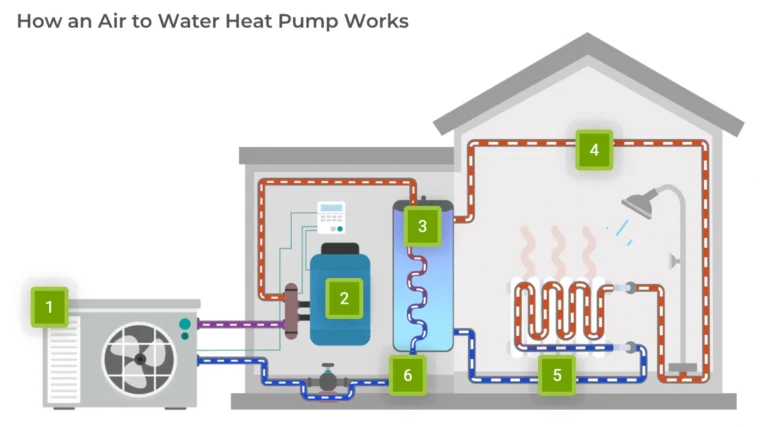
The pros and cons – what are they?
So – you’re seriously considering a domestic air source heat pump. Doing your research is an essential for any investment, particularly one that has the potential to affect your home and your pocket.
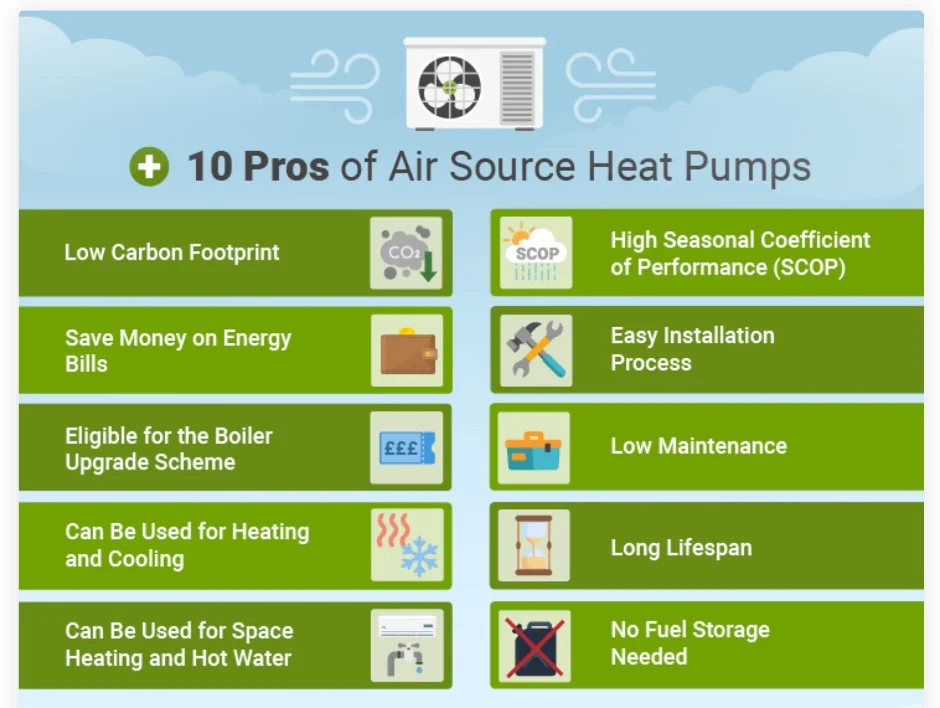
Air source heat pump – advantages
Low carbon footprint
Air source heat pumps are a low carbon emissions heating option – they use the outside air to heat or cool homes at a highly efficient rate. For every 2.5-2.8 units of energy produced, only 1 unit of electricity is used.
Cash saving
Switching to air source heat pumps can potentially reduce your annual fuel bill with larger savings for those switching from LPG, coal or electric systems.
Boiler Upgrade Scheme
The soon to be £7,500 grant from the Boiler Upgrade Scheme is available for the installation of air source heat pumps as well as ground source heat pumps.
Cooling and eating
ASHPs, depending on the model, can be used for both cooling in the summer and heating in the winter.
Space and hot water heating
An air source heat pump can also heat water if the flow temperature is around 55°C. If it’s only for space heating, the flow temperature will be 35°C.
High SCOP
Air source heat pumps have a high SCOP or seasonal coefficient of performance, making them efficient in summer as well as winter. When the outside temperature is above 7°C, a typical COP of 3.2 is achievable.
Easy-ish Installation
In taking as little as 2 days air source heat pumps are some of the most straight forward to install. Unlike ground source heat pumps there’s no need for ground works – drilling and digging etc. They’re also suitable for new builds and retrofits and are cost-effective when combined with other building work.
Low maintenance
needing little maintenance apart from the occasional filter cleaning, leak checking and toping up refrigerant levels – all can be done by the homeowner, air source heat pumps should be services annually by a qualified heating engineer.
Long lifespan
With proper maintenance, air source heat pumps have a long lifespan and can operate for up to 20 years and most have 5-year extendible warranties.
No fuel storage
Fuel storage isn’t needed with ASHPs, so there’s no additional fees for fuel deliveries etc as there is with biomass or oil-fired boilers.

Disadvantages of air source heat pumps
With air source heat pumps known for their affordability and versatility, they also have some disadvantages that you need to be aware of.
lower heat supply compared to boilers
Compared to oil and natural gas boilers air source heat pumps have a lower heat supply. So, it’s likely that you’ll need larger radiators – potentially double the surface area to produce a similar amount of space heating.
Additional spending to put in underfloor heating
to make the most of a heating system, underfloor heating is often used alongside an air source heat pump. This additional cost as well as disruption of having floors raised and reset should be taken into consideration.
A well-insulated home is a must
If you don’t have a very well insulted home – walls, windows, loft/roof etc, you’re unlikely to see cost savings. You may even see a significant increase in electricity spend as the pump will use more energy to generate heat.
Lower efficiency below 0°C
As air source heat pumps rely on outside air, they lose efficiency below 0°C. with the temperature drop decreasing overall heat output.
Reduced savings compared to cheap (mains) gas
For people with a large differential between the cost a unit of gas and electricity, running cost savings may be possible but should not be expected. With current cost per kilowatt hour at 33.71p for electricity and 9.81p for gas (Southeast – Sept 2023) you’ll need to do a careful calculation based on usage etc to determine if there’s going to be a saving.
Noisy operation
When they are running Air source heat pumps are not quiet.
Between 40 and 60 decibels on average should be expected – similar noise level to a dishwasher or microwave. And current building standards limiting this to 45dB if the air source heat pump’s a meter of less from a neighbour’s window.

Air Source Heat Pumps for older homes
With their efficiency and their money saving potential air-source heat pumps Victorian and Edwardian home owners, are increasingly asking about whether the technology could work for them.
Historic England’s recent publication on installing heat pumps in historic buildings and pre-1900 homes goes into this in 60 plus pages of detail.
The conclusion reached was that heat pumps are potentially viable, but that quite a bit of additional work is normally needed including ductwork, renewing pipe and along with major insulation.

Design considerations – heat pump loads in older building
When planning a heat pump installation in an older home, understand the heating and cooling loads involved to maintain a comfortable temperature is essential.
This means a careful review of window types, ductwork and of course insulation levels are needed, and you shouldn’t progress things until you have these completed and in your hands.
Can I prepare my home for an ASHP?
Getting a few things sorted in advance will help to ensure you have a successful ASHP installation.
Adequate outside space – ideally south facing
With its outdoor module placed either on a wall or directly on the ground air source heat pumps need to have sufficient space including room for a good flow of air. To get the greatest efficiency, it should ideally be located on your home’s south side, with the accompanying temperature sensor placed on the north side.
Insulation’s a must
Make sure that you’ve got proper floor, wall and loft insulation as well as draught-proofing otherwise your air pump will not work efficiently and may well end up costing you more to run than the system it replaced.
Energy Performance Certificate – get one
EPCs document your property’s energy efficiency through rating it from A (very efficient) to G (inefficient). You’ll need this to enable the air pump installer to discuss the available options. You’ll also need an EPC if you plan on applying for a Boiler Upgrade Scheme (BUS) grant.
An air source heat pump – how much does installation cost?
Compared to ground source air pumps, air source heat pumps are typically cheaper to install – as they avoid the digging and drilling needed for the pipes used to extract heat from underground.
With the Boiler Upgrade Scheme (BUS) introduced in 2022, the available homeowner grant helping with the purchase and installation of air source heat pumps has increased recently (October 2023) by 50% to £7,500. So, taking this into account the £8,000 to £18,000 that you might expect to spend on buying and installing an air source heat pump has dropped considerably to between £500 and £11,500.
The cost gap reflects differing installation complexities and of course air pump features – size, functions and performance efficiencies etc.

What’s the running cost?
With heat pump running costs, the system size and efficiency will naturally play a huge part. The larger the heat pump, the more energy it will produce, and the more expensive it will be to run.
System efficiency is equally as important to bear in mind.
Air source heat pumps will always be more efficient in warmer climates. But this doesn’t mean they’re not cost-effective during the UK’s cold weather. The performance drop-off up until freezing temperatures are reached i.e. 0°C is negligible. Fortunately, UK winter temperatures don’t often fall this low.
Moreover, your own energy needs and of course your home’s insulation will also impact the running costs. And to get the most out of your heating system, your home must be well insulated.
How much could I save with an air source heat pump?
Having an air source heat pump (that’s appropriate and correctly installed) will save energy and money! The efficiency of all heat pumps is measured by the Coefficient of Performance (CoP) discussed earlier. In most circumstances, air source heat pumps have an expected CoP ranging from 2.5 to 2.8. This means that for every single KWh it uses, an air source heat pump will produce 2.5-2.8 KWh of heat.Based on EnergySavingTrust February 2023 fuel and carbon data the annual savings of switching to an air source heat pump are:
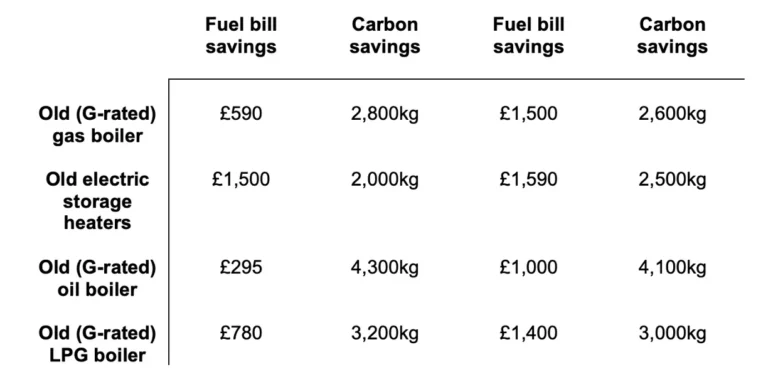
So, it is possible to save a reasonable amount annually depending on where you live and what system you’re switching from.
And if you move from an old G-rated gas boiler, an air source heat pump will save you coming up to 3,000 kg of CO2 annually. That’s equivalent to planting over 40 trees!

Ground source heat pumps
What’s a ground source heat pump? And how does it work?
A ground source heat pump absorbs heat from one place – the ground and transports and releases it to another location, in this case, your home.
As with other heat pumps, it can be used for domestic water heating as well as space heating – underfloor and radiator heating.
Vertical ground source heat pump sytems
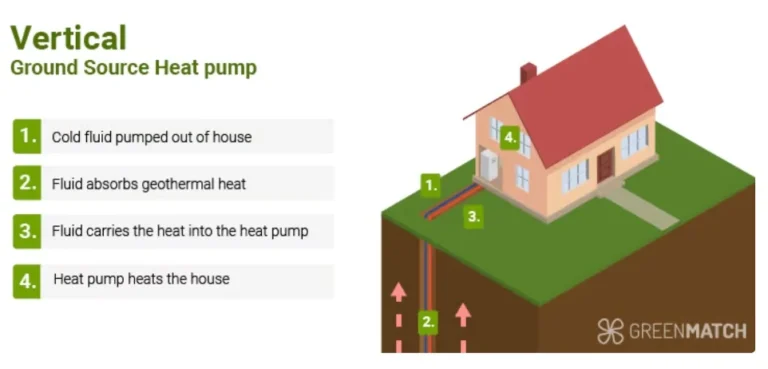
Vertical ground source heat pumps use one or more borehole to extract heat from the ground. They’re ideal for suburban homes where space is restricted and there’s not enough room to lay pipes horizontally.
With these, a hole is dug into the ground for insulation and piping laid between 50-150m deep depending on the composition of the earth and your home’s heating needs. Bore holes should be a minimum of 6m apart to avoid freezing the ground.
At depths, temperature increases, warming the pump’s anti-freeze liquid. This returns through an exit hole to heat the refrigerant which stays in the house within a second system.
Due to the needed ground works, the initial investment is high and potential disruption large.

Horizontal ground source heat pump systems.
This ground source heat pump system is laid in horizontal trenches that are approximately 1-2 metres deep. Its less complex than a vertical system and less costly.
The installation requires the ground to be dug out just below the frost line and coiled pipes (slinkys) laid down into the ground, creating spirals. A liquid is then sent through the system heating up the second pipe system’s refrigerant.
This system, although more affordable than vertical system requires greater garden or outside space. It’s also affected by seasonal changes with lower depths of the system’s installation.
The typical 150m2 home needs an area of between 300 and 700m2.
Open and closed systems – the difference is?
The open loop system extracts clean groundwater to directly pass through a heat pump where heat is extracted. Drawing heat from the ground, the closed loop system uses a continuous loop of piping connected to an indoor heat pump.
An open loop system is generally cheaper to install and requires groundwater to be available. Whereas closed loop systems tend to be more reliable, require less maintenance, and are extremely efficient due to extracting heat from the earth.
Ground loops vary in size but are usually the region of 200 metres long. Many homes are likely to need two or three with separation between each of them. So, you’re looking at having an area of 700-800 square metres to work with.
Ground source heat pump efficiency
Ground source heat pumps have on average an efficiency of between 300% and 400%.
So, 3-4 kilowatts of heat is generated in return for every kilowatt (kW) of electricity consumed.
If you’re considering a ground source heat pump, remember the UK regional soil’s thermal properties vary considerably and will affect a ground source heat pump’s efficiency.
Are ground pumps efficient even in cold weather? And what about when it’s hot?
With ground source heat pump’s external pipelines inserted a meter and more in the soil, temperature is comparatively stable for all 12 months of the year.
The result is that a ground source heat pumps efficiency is very unlikely to be affected significantly by either the hot or cold weather you’d experience in the UK. And even less so where you have a vertical GSHP in place.
How much space do you need for a ground source heat pump?
Horizontal GSHPs require a considerably larger amount of space than vertical ground source heat pumps.
With a typical home’s system, two or more ground loops will be needs so you’ll be looking at 600m2 to 1200m2 of clear land. And with the majority of horizontal collector arrays you’ll also need trenches of a 100m plus.
If space’s is restricted, it’s possible to lay the pipes in circular loops (slinkies), but these aren’t as effective or efficient as straight lines.
With vertical systems the surface area needed is much smaller, but you do need to have the ground structure needed to dig and maintain lasting boreholes.
As you’d expect, the borehole numbers and depth will depend on system’s size and type as well as soil and deeper ground make up. Giving you an idea, three boreholes with a depth between 70m to 120m would be needed typically for an 8kW ground source heat pump system.
Install a ground source heat pump – how long does it take?
Once planning and the necessary permissions have been obtained, it typically takes up to a week for groundwork and the laying of the full ground source heating system.
Installing the heat pump unit can usually be done in a day. Digging boreholes and laying piping in the ground are more complex and depending on geological conditions typically take at least a day and can be two or three days.
Is planning permission needed for a ground source heat pump?
As installing a ground source heat pump is considered a permitted development generally in England and Scotland – most homes won’t need special planning permission to install one. The exceptions are Northern Ireland and Wales where special planning permissions are needed.
For listed building and where multiple ground source heat pump are being installed, planning permissions are required.
Groundwork costs of vertical vs. horizontal systems
There is a significant difference in groundwork costs between vertical and horizontal systems. Although the horizontal installation is cheaper it requires, on average, anywhere between 600m2 to 1200m2 of clear land.
Groundwork and installation costs

How much money can you save with a ground source heat pump?
The following table’s based on figures from the Energy Saving Trust, and shows the potential carbon and energy bill savings when using a ground source heat pump in England, Scotland and Wales, under the current energy price guarantee.
NB. The systems listed are all non-condensing systems.
Carbon dioxide energy bill saving

Advantages and disadvantages of ground source heat pumps
A promising technology that can help reduce reliance on fossil fuels and lower carbon footprint, ground source heat pumps are certainly worth looking at.
But before you take the jump make sure that you understand both the advantages and disadvantages.
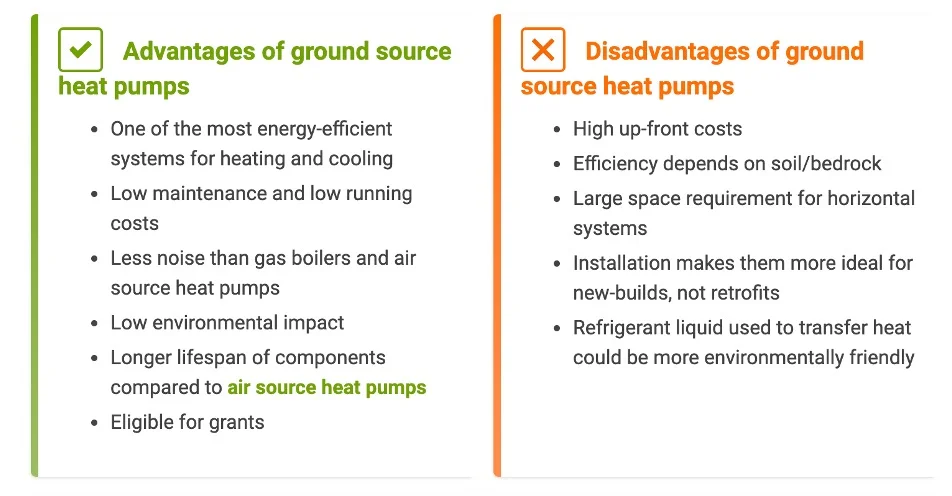
Underfloor heating system vs. radiators
Radiant floor heating and ground source heat pumps work well together and a great way to get the most out of your heat pump.
As you would expect, an underfloor heating system performs better than radiators but costs significantly more to install. With underfloor heating, heat is transferred equally across an entire surface, whereas with radiators it’s spread from individual locations and circulates by convection through an entire room.
Having an existing underfloor heating system in place would be the ideal situation and gets away from any new additional cost. If you go down the radiator route, to achieve the same warmth and ambient room temperature as with a gas boiler, you’ll need to replace your radiators with ones with a larger surface area.
Are there government grants for ground source heat pumps?
The answer’s yes – and please click here to find out more.
FAQs
How much land do you need for a ground source heat pump?
A home with 150m2 would need an outdoor area between 300 and 700 m2 for a horizontal ground source heat pump to be viable.
If you don’t have the required space, it’s possible to vertically install a ground source heat pump. With this for insulation, a hole’s dug at least 6m into the ground and between 50m 150m of piping would be typically needed to produce sufficient heat for an 8kW ground source heat pump system.
Is a ground source heat pump a good investment?
Ground source heat pumps are an environmentally friendly and potentially effective investment.
- If you qualify for a grant and your home has a high energy efficiency rating, then a ground source heat pump (GSHP) may very well be worth it.
- They come with many long-term benefits. By getting a new ground source heat pump, when switching from another electric heating system its’ possible to save £1,100-2,000/year on your heating bill. And if you switch from a gas-fired heating systems savings may be in the region of £670 or more.
- If you’re switching from a gas boiler, then a ground source heat pump will significantly reduce your home’s carbon footprint.
- Long life span. Heat pump components will typically last circa 25 years, with estimates for ground loop systems exceeds 50 years and sometimes climbing up to 80 years.
- Ground source heat pumps are the most efficient type of heat pump and out-perform air source heat pumps and water source heat pumps. In particular ground source heat pumps have constant performance throughout the year which can be an issue for air source heat pumps.
Water source heat pump?
Water source heat pumps have been in use since the late 1940s. They use the constant temperature of water as an exchange medium instead of extracting the heat from the outdoor air temperature as with air source heat pumps and the ground which ground source heat pumps use.
Water sources are wide ranging and include groundwater aquifers, lakes, abandoned mines, canals, the sea and of course rivers.

Closed and open loop systems
There are two main designs – open loop and closed loop systems. Open loops are used with boreholes near flowing water, rivers etc, and closed loops in large ponds, lochs or lakes where there is little if any water movement.Closed loop
This will be the lowest-cost option if there’s a sufficient body of water near your home.
Like ground source heat pumps, closed loop systems use submerged sealed anti-freeze fluid filled pipes to gather heat – and in this case from water as opposed to the ground. As fluid is pumped through the pipes, it absorbs heat energy from the water. Fluid is then circulated back to the heat pump.
Open loop
Rather than using a fluid to transfer the heat through submerged pipes, open loop systems take water from a borehole, lift it to the surface, then extract heat energy before returning the cooled water to a separate borehole.
With no anti-freeze, there’s an increased risk of loop pipes freezing – as colder water leaves the heat pump. A sufficient flow of water is needed to combat this.
Open loop is practical only where there is a reasonable supply of clean water. A filtration system or other forms of water treatment will be needed to obtain the necessary licenses. Furthermore, a corrosion-resistant system needs to be used as a large amount of water’s pumped through the pipes.
Environmental legislation to bear in mind
Specific environmental regulations and considerations must be addressed before installing water source heat pumps. Open-loop systems alter the temperature of groundwater, while thermal plumes affect hydrochemistry and bacteriology.
Licences may be required depending on the type of system installed. For example, hydrogeology and thermal properties have to be investigated – requiring a licence to examine groundwater, and an abstraction licence (permission of diverting surface or groundwater).
For more information on licences please click here and you’ll be taken to the guidance you’ll need to follow.
Water source heat pump – how much do they cost?
The cost for a water source heat pump is around £10,000 with the same £7,500 grants and 0% VAT breaks as with ground source heat pumps. Expected lifespan is 15 years, but with regular maintenance they can last upwards of 50 years.
FAQs
How does a water source heat pump work in the winter?
WSHP’s work by extracting heat from a body of water and converting it to heat energy. During winter, the working fluid in the submerged pipes absorbs heat from the surrounding water, which is transferred via a water loop to the unit’s refrigerant-to-water heat exchanger, and then the properties central heating.
In more extreme weather, WSHP’s may require an additional energy efficient fluid heater to maximise heat absorption and transfer. In any case, the process of how these systems work depends on the type you opt for; closed-loop, hybrid, or open-loop systems.
What pond size do I need for a water source heat pump?
Lakes and ponds on average would provide at least 1kW of energy per 50 m2 of surface area. As such, rivers, lakes and ponds often serve as reliable water sources for average heating demands. If unavailable, underground aquifers, wells and sewers could serve as potential sources. It is also advised to be within a 100m distance to your water source to optimise heat transfer to your property.
For larger than average heating demands, software modelling by a professional heating engineer is highly advised to gauge your water body requirements. As a rule of thumb, the more heat you’ll need to generate, the larger the water source you’ll require.
Wells – can these be used as a water source for a heat pump?
Generally speaking, yes. A well could be utilised as a water source for a heat pump, depending on its water temperature and capacity. For an accurate gauge of its potential, consulting with a professional heating engineer is highly recommended.
Who are the best water source heat pump manufacturers?
There are a number of water source heat pump suppliers. Three of the most popular are Kensa, Daikin and Mitsubishi Electric.
How efficient are water source heat pumps?
Water source heat pumps are considered the most efficient of all heat pump options, and arguably of other energy solutions too. They are an estimated 4-5% more efficient than their ground source counterparts, thus providing a whopping 300-600% energy efficiency potential.
What are the running costs of a water source heat pump?
There are basically three factors that affect the running cost of a water source heat pump, which are similar to the running cost of an air source heat pump: the size of the property and the amount of energy needed for heating it; the operating efficiency of the water source heat pump and the temperature of the source of energy.
The coefficient of performance (COP) of a water source heat pump can be as much as COP 5, whereas the standard COP for heat pumps is in the range of 3.0 to 4.3. The efficiency of a heat pump signifies the amount of work it has to perform – the variation between indoor and outdoor temperature degrees. The running costs will also depend on the desired temperature output. The smaller the gap of temperature differences, the less the heat pump needs to work and therefore the operating costs will be lower. However, to achieve temperatures of 65°C or more, the heat pump’s efficiency will fall and running costs will increase.
The most common reason for unreasonably high running costs is faulty installation or installation in ill-suited properties.
Why choose a water source heat pump?
Using water source heat pump as an energy source has a number of advantages when compared to air or ground source heat pumps:
- The heat transfer rate from water is much higher than from air or ground.
- The constant flow of the water means that there is a continual energy replacement.
- There is no need to dig large trenches to install the water source heat compared to a ground source heat pump. That also makes the installing process less costly.
- The return temperature of the water is generally higher than the one of winter air or ground, increasing the performance efficiency of the heat pump.
- Choosing water source heat pump over conventional energy sources will significantly reduce carbon emissions.
- Water source heat pump reduces monthly heating and cooling costs. The monthly utility bill decreases approximately by 15 percent after installing this efficient
Sharing a heat pump?
Well, we know that heat pumps, air and ground source, probably more than water source, are expected to play a major part in cutting the use fossil fuel gas in heating our homes.
At the moment there’s lot’s being written about district heat networks. With these, energy is produced from large scale waste or low carbon power plants to heat local high density urban areas.
For homeowners in the right location, this looks a great idea. Especially, as they won’t be responsible for the installation and maintenance of any kit.
Nimbyism aside, (would you want to live next to a supersized tip or recycling station?) realistically this type of heating in the UK’s quite some way off – with little current political excitement and 2050’s net carbon zero taget some way off.
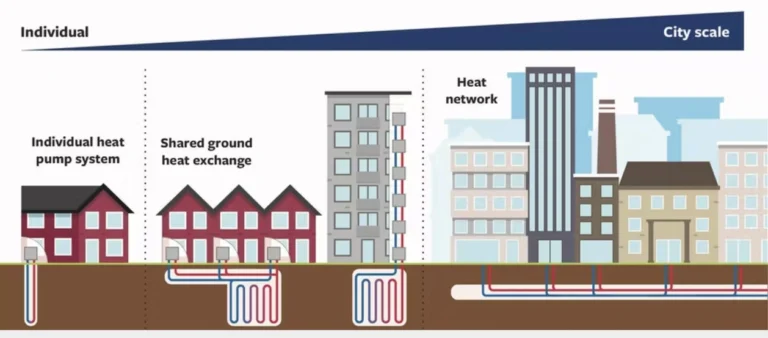
Shared ground loop?
More workable, and of course on a different scale are shared ground loops or shared ground heat exchangers. With these, local community or potentially streets collectively fund the installation and maintenance of their own joint heat pump boreholes and infrastructure.
As with regular ground source heat pump system, the ground loop collects thermal energy which is then provided to individual connected home’s heat pumps.
They differ from district heating networks not only size wise, but they also enable multiple individual heat pumps to be served by one ground loop flexibly.
Shared ground loop advanages
Independence
Homeowners have their own heat pump, powered by their own personal heat supply. This ensures individual billing and the way to set the heating system the way it’s wanted and not according to a communal standard.
Cost savings
Requiring fewer boreholes, the installation and maintenance costs for a shared ground loop are lower than for an equivaent individual ground source heat pump system.
Versatility
Suited to pretty much any building – whether retrofits or new homes, shared ground loops are extremely flexible.
Also, the loop can be expanded at any time to meet increasing demand. And importantly, boreholes can be distributed flexibly and more optimally preventing the ground from freezing and losing its ability to provide heat.
Resilience
Each heatpump is entirely independent, so if there’s a fault with one individual heat pump, it won’t affect any other heat pump connected to the system. And when a heat pump has its regular maintenance or goes down, no other heat pump is affected.
Funding for shared ground loops?
Grants and other financial assistance are available through the Green Heat Network Fund (GHNF). Initially worth £288m, the fund opened in March 2022. Since, further funding has been made available and can be drawn down to the end of 2027.
As of June 2023, over £117 million has been awarded.
To access grants, projects need to reach a threshold of 2GWh per year – which may prove to be a barrier except for the largest schemes.
See you soon....
That’s it for today! Until next time, you can always find us on www.angusplumbing.co.uk (we’ve a great on-line booking mechanism) or on Instagram, Facebook and YouTube. Or, if you wanted to, you can call, text or WhatsApp us on 07442 966664.
We’d love to hear from you, especially if there’s something, you’d like us to blog about.
All the best for now
The ANGUSplumbing team




